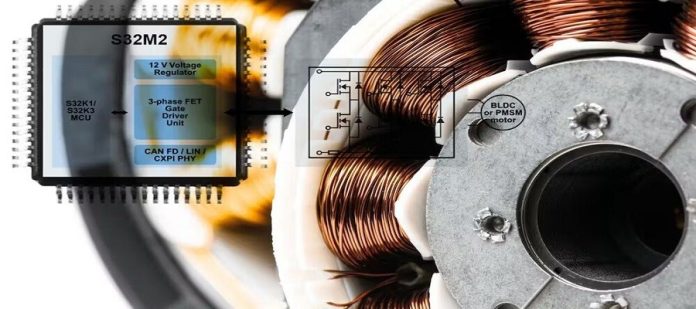In a significant stride towards advancing motor control technology in modern automobiles, NXP Semiconductors introduces its latest family of motor-control MCUs. The S32M2, part of this new lineup, is meticulously designed to elevate the performance of brushless DC (BLDC) motors and other electric motor applications that are increasingly prevalent in contemporary cars and industrial motor drives.
While NXP’s existing S32K family focuses on the traction motors integral to electric vehicles (EVs), the S32M2 takes center stage by concentrating on a myriad of motors within cars. These motors are responsible for tasks such as automatically opening and closing trunks or windows and adjusting seat positions or side mirrors. Diverging from the system-on-chip (SoC) strategy employed by the S32K, the S32M24x and S32M27x models adopt a system-in-package (SiP) approach, integrating a diverse range of power and analog features tailored specifically for motor control.
Key to the S32M2’s capabilities is its single-core Cortex-M4 CPU, clocked at up to 80 MHz, or the option of a Cortex-M7 clocked at 120 MHz, coupled with a single-precision floating-point unit (FPU).
This enhancement provides superior performance compared to its predecessors, enabling the MCU to efficiently manage advanced motor-control software, facilitating quieter and more effective motor operations. The MCU is complemented by 128 kB to 1 MB of on-chip memory.
A distinctive feature of the S32M2 is its integration of power circuitry and analog circuitry within a compact 64-pin LQFP package. NXP highlights that this integration not only conserves space on the printed circuit board (PCB) but also mitigates design risks.
In contrast to traditional “brushed” electric motors, BLDC motors and permanent-magnet synchronous motors (PMSMs) are gaining prominence due to their smaller size, lighter weight, reduced noise, and enhanced durability and power efficiency. However, integrating a BLDC motor involves a more intricate electronic control system.
Traditional brushed DC motors rely on brushes and a commutator for rotation, causing wear and potential power loss. In contrast, BLDC motors employ advanced electronic control techniques facilitated by the MCU. The MCU precisely controls the gate driver, managing the FETs that supply current to the motor’s windings, resulting in more accurate and efficient motor operation.
The S32M2 is equipped with a broad array of I/O for sensor connections, enabling real-time monitoring of motor position and operation. Integrated current sensing further contributes to minimizing power losses. High-performance MCU cores manage motor speed and torque meticulously, while additional analogue peripherals include timers and high-precision analogue-to-digital converters (ADCs) for optimal control.
NXP emphasizes that the S32M2’s capabilities extend to advanced motor control methodologies, including state-of-the-art field-oriented control (FOC). This approach eliminates the need for position sensors by sensing voltage in the windings, enabling precise adjustment of motor-control outputs.
A significant component of the S32M2 is its three-phase gate driver, capable of driving up to six external power MOSFETs. This enables control over a single three-phase BLDC (or PMSM) motor or up to three single-phase brushed DC motors simultaneously.
Moreover, NXP underscores the S32M2’s compatibility with its existing S32 platform, offering flexibility for software reuse across different generations of vehicles. This compatibility extends to the company’s software and development tools, ensuring seamless integration with NXP’s established offerings.
In addition to supporting ASIL B functional safety under the ISO 26262 standard, the S32M2 incorporates NXP’s hardware security engine (HSE) and other security subsystems, providing a secure foundation for automotive applications. The MCU’s programmable slew rate and voltage regulator further enhance its adaptability, while firmware over-the-air (OTA) updates are supported, ensuring continuous improvement and innovation in the rapidly evolving automotive landscape.









